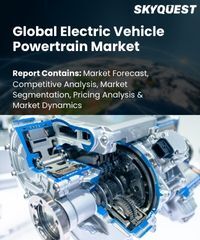
Report ID: SQMIG25A2065

Report ID:
SQMIG25A2065 |
Region:
Global |
Published Date: February, 2024
Pages:
257
|
Tables:
62 |
Figures:
75
Electric Vehicle Powertrain Market Drivers
Stringent Gas Emission Regulations to Bolster Market Growth
Electric Vehicle Powertrain Market Restraints
Lack of Infrastructure to Hinder Market Growth
Our industry expert will work with you to provide you with customized data in a short amount of time.
REQUEST FREE CUSTOMIZATIONElectric Vehicle (EV) Powertrain Market size was valued at USD 88.25 billion in 2021 and is poised to grow from USD 118.87 billion in 2022 to USD 956.44 billion by 2030, growing at a CAGR of 5% in the forecast period (2023-2030).
Global electric vehicle powertrain market is highly competitive and somewhat fragmented. To maintain a competitive edge, the major industry participants are continually implementing various growth strategies. Innovations, mergers, and acquisitions, collaborations and partnerships are adopted by these players to thrive in the competitive market. In order to provide industries with the most effective and economical solutions, the major market players are also continually concentrating on R&D. Continental, Bosch, Magna, Mitsubishi, Hitachi dominate the electric vehicle powertrain market growth. Stable distribution and supply chain networks at a global level and portfolios gives an extensive product range are likely to lead to the dominant key players retaining their positions. 'Tesla, Inc.', 'BYD Company Ltd.', 'Continental AG', 'BorgWarner Inc.', 'Magna International Inc.', 'GKN PLC', 'Aisin Seiki Co., Ltd.', 'Denso Corporation', 'Robert Bosch GmbH', 'Hitachi Automotive Systems Ltd.', 'ZF Friedrichshafen AG', 'AVL List GmbH', 'Ricardo plc', 'Valeo SA', 'Siemens AG', 'Infineon Technologies AG', 'Toshiba Corporation', 'Mitsubishi Electric Corporation', 'LG Chem Ltd.', 'Panasonic Corporation'
Stringent regulations by the Governments for vehicle emission is expected to drive the market growth. Increase in carbon and particulate matter emissions from automobiles have resulted in severe depletion of air quality, which has a negative impact on human health and the environment. As a result, governments all over the world have imposed stringent emission standards on automobile manufacturers. As a result, manufacturers have increased R&D for electric vehicles to provide customers with a cost-effective alternative, which has fuelled the growth of e-powertrains.
Increase in demand from OEMs: Electric vehicle powertrain design to cost (DTC) approaches are increasingly being used by OEMs for electric vehicle powertrain simulation. This trend has been especially noticeable in second-generation EVs. The DTC approach is primarily concerned with making better use of lightweight materials in structural parts and integrating components in the e-powertrain.
Asia Pacific is expected to grow significantly during the forecast period. The primary driver of the high market penetration includes regulatory programmes encouraging EV sales, such as EV sales quotas, fuel economy targets, and EV advantages in licence plate assignments in countries such as China. Strict emission regulations, such as BS-VI in India and China VI in China, are propelling the e-powertrain market in this region. Partnerships between leading players to build charging infrastructure are driving market growth in this region. For example, China's Didi Chuxing and British oil giant BP collaborated to build EV charging infrastructure in China. China has lithium reserves, which is driving up investment in battery production. Tesla also launched the Model 3 in South Korea at a significantly reduced price due to favourable government incentives. These factors are likely to lead to APAC's dominance in this market.
Want to customize this report? This report can be personalized according to your needs. Our analysts and industry experts will work directly with you to understand your requirements and provide you with customized data in a short amount of time. We offer $1000 worth of FREE customization at the time of purchase.

Report ID: SQMIG25A2065